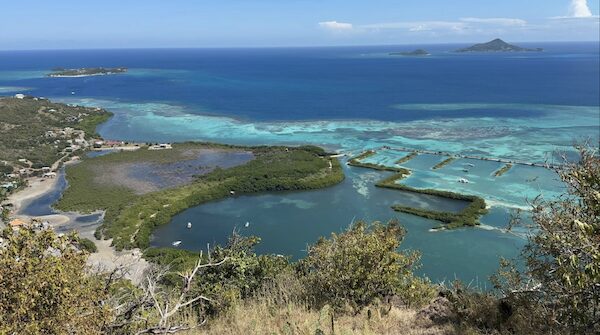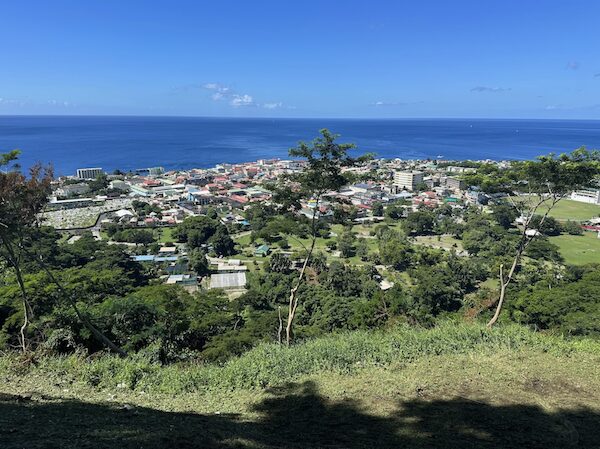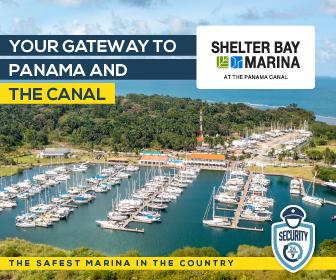Caribbean Cruising: Tropical Paradises with Diversity and History
Dutch sailors Floris van Hees and Ivar Smits – Sailors for Sustainability – spent several months in the Caribbean at the end of the 2023 Hurricane Season, as they neared the end of their circumnavigation. In this report, written before the devastation of Hurricane Beryl in July 2024, they discovered for themselves why so many sailors adore the Caribbean and linger there for months on end.
Published 9 months ago
It should be noted that Carriacou and Union Island – mentioned im this report – were severely affected by Hurricane Beryl and may take years to return to what Floris and Ivar discovered. See more details here.
So Much Comfort and Convenience
“I get it,” Ivar says while sipping on a cocktail. “Rum punch, nice weather, and sandy beaches; no wonder so many sailors adore the Caribbean and linger here!” We arrived in this cruising area only recently and are still settling in. Not because of any inconveniences, but because we are not used to so much comfort and convenience.
Grenada – Carriacou
Our yacht Luci is anchored in front of a stunning beach, which is appropriately called Paradise Beach (on the island of Carriacou, a dependency of Grenada), while we enjoy drinks and pizza with friends at the eponymous club. It’s a hit with sailors, as evidenced by the hundreds of hand-painted nameplates of the crews that visited before us. Tonight is the club’s season opening and it is packed. Are we experiencing something typically Caribbean? Despite the good vibe, we secretly hope that there is more to it. Will we find another side of the Caribbean on the next island?


St. Vincent & the Grenadines (SVG) – Union Island
We can literally see the next country on the horizon. Union Island is only a short sail away and belongs to Saint Vincent and the Grenadines. The small distances between islands in the Caribbean are another convenience we’re not used to (as we near the end of our circumnavigation).
A few hours after clearing out of Carriacou, we can drop the anchor again. At first sight, Ashton Lagoon on Union Island is a typical Caribbean bay, however, on our way to shore we notice a few oddities, such as rectangular basins, overgrown dams and heavily rusted piles. They are the remains of a failed marina development project. The marina was never completed, but the construction efforts still cost the lives of mangroves and marine creatures that depend on them.


Healthy Mangroves
Fortunately, things are better now thanks to SusGren (Sustainable Grenadines). The local NGO restored the flow of seawater to the mangroves and planted thousands of tree saplings. Two employees show us around the lagoon and tell us about the benefits of healthy mangroves for nature and people. The mangroves are home to countless birds, young fish, crabs, and shellfish.


The mangroves also protect the coast against storm surges and store CO2. Ashton Lagoon is a beautiful example of an ecosystem returning to its original state and enjoying better protection, after big capital had led to its near destruction. We think it’s wonderful that these types of initiatives can be found in the Caribbean, too. It’s a side of the Caribbean we didn’t expect. For more about mangrove restoration at Ashton Lagoon, please read the article we dedicated to this inspiring sustainable solution.
Watch the Weather
We have gotten so used the constant north-easterly wind that we neglect to look at the weather forecast daily. Fortunately, the habit to check the weather still runs deep, so we still notice a tropical storm heading our way. The rapidly deepening depression named Tammy reminds us that the hurricane season is not over yet. We realize, too, that anything can happen due to unusually high sea water temperatures. Should we seek shelter in a hurricane hole, preferably one surrounded by mangroves? Over the course of the next days, we keep a close eye on the forecast, until it becomes clear that Tammy stays far north of us. Still, we experience its effects: heavy showers and a big swell. Who said the Caribbean is always sunny?
SVG – Tobago Cays
Once the weather improves, we sail to the Tobago Cays. It is a popular destination, and we understand why when we explore the area’s underwater world. Sea turtles nibble undisturbed on the sea grass while a ray swims gracefully by. At the coral reef, a school of silver-coloured fish observes us from their hiding place. These waters are well protected, and it shows. The marine life is truly enchanting.


The scene above water is also Caribbean, albeit the touristy kind of Caribbean. “Boat boys” – locals in their wooden boats – patrol the mooring field, ready to assist visiting sailboats with picking up a mooring ball. In the evenings, they organise lobster barbecues for the tourists. It’s not the Caribbean setting we are keen on, since we haven’t seen lobsters all day and fear that they are gradually becoming an endangered species around here.
SVG – Bequia
While we decide where to sail next, we get a message from our friends Oda and Onno on SY Off Course. They rave about Bequia, which is – surprise – only a day sail away. The wind is favourable again, too. Upon arrival, we immediately understand why it is bustling with sailboats. The colourful village is lively thanks to its restaurants, shops and stalls with fresh vegetables and tropical fruit.
The surroundings are stunning. On Oda’s advice, we follow a hiking trail through the forest to the top of a hill. It’s quite a climb in the scorching heat, but we are rewarded with magnificent views of the island. Back on the beach it is time for a game of volleyball with other sailors. Why would we ever want to leave here?
Well, grocery shopping could be a reason.
While locally grown fruits and vegetables are quite affordable, everything else is very expensive. Since the bottom of our supplies is in sight, we decide to sail to Martinique. For the first time, we sail past islands without visiting them; skipping islands is part and parcel of sailing in the Caribbean, too.
Martinique – Sainte-Anne
After a night of sailing, we drop anchor at Sainte-Anne, where we soon feel as we are in France (because we are!): French street signs, French cars, a typical French église (church) and delicious French cheese and almond croissants. And everything is sold at reasonable European prices.


Rum and Art
However, it’s not all joie de vivre. On a tour of the island, we are reminded that many enslaved Africans were brought here during French colonial times. The open-air museum named ‘Slave Savannah’ shows in a compelling way how these people were forced to work and how cruelly they were treated. The enslaved often worked on sugar cane plantations and were therefore a key factor in the production of sugar and rum.
Fortunately, better times came after the abolition of slavery and the dark past is now acknowledged. At Clément, one of the island’s historic rum houses, sugar cane is still grown and rum is still produced, albeit in a modern facility. The old factory is an industrial heritage site where the slave labour on the plantations is commemorated. The adjacent sculpture garden is full of contemporary art, with some sculptures depicting the horrors of the past. Modern art with an important message: it too can be found in the Caribbean.
Hiking on a Volcano
We continue to sail northward along Martinique’s coast. In Saint-Pierre we anchor just outside an area marked with yellow buoys. It is indicated on our chart as an area teeming with shipwrecks that sank during a catastrophe in 1902. That year, the volcano Mont Pelée erupted. The eruption destroyed Saint-Pierre within minutes, killing almost 30,000 people. Only one prisoner, who was in an isolation cell with thick walls, survived the cloud of hot ash that rushed down the mountain.


These days, the volcano is closely monitored, so we start our hike with confidence. It’s a bit of climb, but when we finally reach the top, the clouds part, if only briefly. We look down on the rebuilt town of Saint-Pierre and our anchorage. The idyllic appearance conceals the catastrophic past. That too is a side of the Caribbean.


Dominica
The wind blows strongly as soon as we leave the lee of Martinique. It gets tunnelled between the mountains behind us and those of our next destination: Dominica. Until a moment ago, we were trying to catch every breath of wind, so all the sails are still up. The boat speed increases to eight knots and we heel considerably. The spray water pours over the deck. “We should reef the sails,” Floris remarks. “You’re right, but our heavy steel lady can handle it,” Ivar judges.


It’s only a short distance anyway, he reckons. Luci seems to be having a great time and is ploughing through the steep waves. But as we get closer to Dominica, a squall passes. The wind increases even more. Ivar changes course to almost downwind to take some of the pressure off the sails. That works, although we get soaked. “Let’s not do that again,” says Floris, looking sternly at Ivar. “No!”
“The acceleration zones between these large, mountainous Caribbean islands are quite intense,” Ivar responds, sheepishly. Of course, we should have known better, as the weather was squally. Fortunately, everything is still intact.
The green mountains of Dominica in front of us are getting bigger and bigger. After the rain, the sunlight makes the deep green forested mountains of Dominica even more spectacular. Clouds of mist rise from the forest and a beautiful rainbow appears. We stare silently at the overwhelming colours. The island is known for its unspoilt nature and in our minds we are already hiking through the tropical rainforest and swimming in waterfall pools.
Welcome to Roseau
The great depth close to the coast brings us back to reality. “Anchoring will be difficult here,” Floris judges. We decide to grab a mooring buoy instead. Mike, a friendly Dominican, jumps into a colourful motorboat to help us moor. On behalf of Seacat, who laid out the moorings for visiting yachts, he welcomes us to his island.
The next morning, we paddle to the Seacat’s jetty and walk to the capital Roseau. Busy traffic, market stalls, and friendly people greeting us are our first impressions. Clearance is a breeze; the immigration and customs officer is friendly and explains that we don’t have to clear out if we stay less than two weeks. That save a trip to the authorities when we leave!
In the nearby museum we learn more about the topography and history of the island. Unlike its neighbours, it has not just one but seven volcanoes! But like its neighbours, it was ruled by various colonial powers in the past. In 1978, it finally broke away from the United Kingdom. It has been an independent state ever since.


Trafalgar Falls
“Let’s go to the Trafalgar waterfall! It promises to be very special” Floris suggests. “Isn’t that a bit far to walk?” Ivar asks. “Yes, we’ll go by minibus,” Floris responds. After we find the correct bus stop, we chat with the other passengers while we wait for the minibus to fill up. Once we leave, Ivar is tasked with opening and closing the sliding door for passengers who get in or out along the way. We are the last ones to get out, as the final stop is close to the waterfall. From the viewing platform, we admire how white masses of water plunge from a dizzying height into the steep depth against a background of countless bright green trees and plants.
“A path must start here somewhere,” Floris ponders, pointing to the edge of the river. “It should lead to a pool where the waterfall’s cold water meets warm water from a hot spring.” But we really can’t see a path. Instead, we notice how the water in the river flows with great force past large and small rocks. Just when we decide that it is not safe, two scantily clad ladies in slippers follow a guide and carefully wade through the river. “If they can do it…”, Floris begins. At that moment another guide addresses us. “It’s safe, I’ll show you the way.” We follow his lead and put our feet where he tells us. Thanks to his guidance, we reach the pool unscathed, where – together with the ladies – we can’t get enough of the wonderful natural pool.
Indigenous Culture
The minibuses cover the entire island. Floris calculates that a return trip to the Kalinago Territory in north-eastern Dominica is possible in one day. After a long bus ride over mountain passes and through steep valleys, we finally stop in a small village. We proceed on foot to the visitor centre of the last remaining community of pre-Columbian inhabitants of the Caribbean: the Kalinago. We are in luck. First, we get an informative tour, then lunch, and to top it off we can attend a dance and music performance given to visiting school children. It’s a pleasure to see that despite the miseries of the past the indigenous culture has not completely disappeared. It even seems to interest the other Dominicans nowadays.


Afterwards, we wait for hours at the bus stop. A Dominican man who also needs a ride gives up and starts walking. How will we get back to the boat? Then a small car stops. It’s the ladies from the waterfall offering us a lift! We can’t believe our luck and squeeze in. We chat all the way to Seacat’s and thank them for the generosity.
The Boiling Lake
“Are you coming with me to the Boiling Lake tomorrow?” Octavius asks, the founder and owner of Seacat. It is said to be the most spectacular, but also most challenging walk on the island, so we think a guide and transport is useful. Octavius turns out to be an excellent guide. He knows exactly the way, which is not always well-marked, and explains a lot about the vegetation and birds.
We listen attentively as we walk through the rainforest, climb steep paths, and occasionally plough through mud. “Why is Dominica so green?” Ivar asks. “Thanks to the primeval volcanic forces that once shaped this landscape. The seven volcanoes, steep mountains, and deep gorges make our island difficult to access and not very suitable for agriculture. That’s why Dominica was spared the massive plantations that replaced the original vegetation on many other islands,” Octavius explains.
When we take a breather at the Boiling Lake, we witness that earth’s primal forces are still quite active here. Every now and then the wind blows the mist aside and we observe that the large lake is so hot that it seems to be boiling indeed.
“Nature tourism is important to us,” Octavius continues. “But we shouldn’t overdo it,” he says while pointing to a construction site in the middle of the national park. We can hardly believe it: a cable car will soon take masses of people from the cruise ships to this natural wonder. It turns out to be quite difficult to find a balance between tourism income and nature conservation. It’s yet another side of the Caribbean. We sincerely hope that the hospitable Dominicans will succeed in preserving their beautiful natural island for future generations.


The Caribbean is so much more than what you first see….
Back on board we soothe our muscle ache with a piña colada from Clément. “The Caribbean cannot be captured in one word. It has so many sides,” Floris evaluates, thinking back to the enchanting sea life, scenic hikes, the rich history, restored mangroves and natural beauty that is under threat from development. “All those islands have rum cocktails, nice weather, sandy beaches, and palm trees, yet they are all different and have so much for to offer,” Ivar adds. Whichever of the Caribbean’s many sides you choose to focus on is completely up to you.
Floris van Hees and Ivar Smits
SY Luci
Sailors for Sustainability
…………………………………
About the Authors:

Dutch sailors Ivar Smits and Floris van Hees gave up busy jobs to circumnavigate the globe with Sustainability being their main goal. They are keen to learn from others worldwide and research and visit as many projects in the countries en route, to take home positive ideas for today’s and tomorrow’s generations.
 They regularly post blogs and vlogs of both their sailing adventures and the sustainable solutions they discover with the aim to inspire people to change their habits. They call themselves “Sailors for Sustainability”.
They regularly post blogs and vlogs of both their sailing adventures and the sustainable solutions they discover with the aim to inspire people to change their habits. They call themselves “Sailors for Sustainability”.
…………………………………
Related Articles, News and Links:
- Sailors for Sustainability
- Portrait of a Cruiser – Ivar Smits & Floris van Hees
- Hurricane Beryl: Aid for both locals and cruisers (Noonsite News July 2024)
- Hurricane Bery’s Destructive Path: How you can help (Noonsite News July 2024)
…………………………………
The opinions expressed in this article are the author’s own and do not reflect the view of Noonsite.com or World Cruising Club.
…………………………………
Find out all news, reports, links and comments posted on Noonsite, plus cruising information from around the world, by subscribing to our FREE monthly newsletter. Go to https://www.noonsite.com/newsletter/.
Related to following destinations: Bequia, Dominica, Grenada, Marigot, Mero, Port Elizabeth (Bequia), Portsmouth, Roseau, St. Vincent, The Grenadines, Tyrell Bay & Hillsborough (Carriacou), Union Island
Related to the following Cruising Resources: Caribbean Sea, Circumnavigation, Routing




